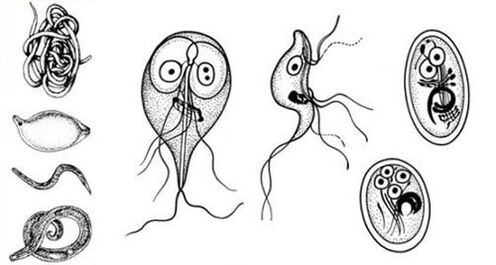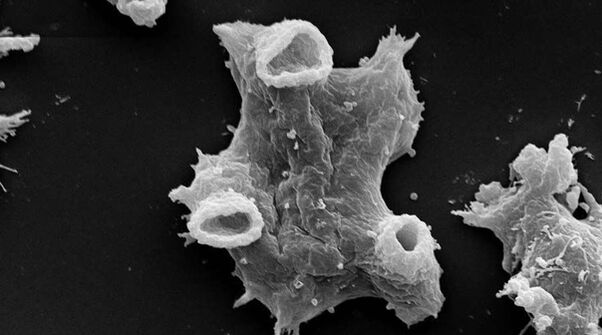Parasitic protozoan microorganisms are commonly referred to as parasites that are constantly present in the human body and feed on its "juices. " They have nothing to do with worms, but some unicellular parasites can reach large sizes.

They are completely independent living beings, although they have lost the digestive vacuum caused by their lifestyle.
Parasite classes
Representatives of different organisms can be classified as follows:
- Sarcode- negleria and amoeba.
- spores- Toxoplasma Plasmodium.
- chilli- balantidium
- Flagella- Leishmania, Trichomonas, Trypanosomes and Giardia.
These beings are one of the first simple beings to appear on the planet. Their elemental structure and functional functions can lead to the development of fatal diseases. The list includes common representatives of protozoan parasites, but there are many more.
Effect on the body
Although these parasites are called protozoa, they have a very negative effect on the human body, causing serious illness.
Sarcode
bloody amoeba (Entamoedahistolytica).The parasite is most common in hot countries. It is characterized by a lack of skeletal and shell formations. He has legs to move. It can form cysts in the human body.
It often causes amoebiasis if the intestinal wall is affected. A person has dilute stools with blood. Diagnosing such an amoeba is quite difficult. It is a very dangerous parasite.
Negleria Fowler.The man is the intermediate farmer. The location of the parasite is usually the brain.
It causes amoebic meningoencephalitis, which is often fatal.
Flagella
Trichomonas (Trichmonasvaginalis).The disease occurs almost asymptomatically in men, only in the form of wear. In women, there are marked signs of inflammation: copious discharge with an unpleasant odor, itching and pain in the lower abdomen.
This simplest parasite is usually spread sexually, but it can also be transmitted through contact. Infected women can infect their baby during childbirth.
Giardia.These microorganisms parasitize in the gastrointestinal tract. The effect on the body is a cystic transmission that lasts for many years, but the disease continues in a mild form. It rarely becomes chronic. By the way, they are not afraid of toxic substances and ultraviolet radiation.
spores
Leishmania (Leishaniaspp).This species is found in almost every human organ and eventually destroys them. Causes serious disease - visceral leishmaniasis. A gaping ulcer forms in their habitat, which is constantly rotting. It is difficult to treat and often requires surgery.
Malaria Plasmodium.It is localized in the blood plasma, erythrocytes and liver cells. The worst part is that these simple organisms kill red blood cells. It leads to tropical and multi-day malaria. It can severely damage your kidneys and break down your nervous system.
Toxoplasma.It affects the lymph nodes and small intestine. Toxoplasmosis often develops, which is very dangerous for pregnant women. It mimics a viral infection in the early stages of infection.
chilli
Intestinal balantidia (Balantidiumcoli).It usually affects the colon, especially the appendix. It is a fairly large unicellular organism that gets easily into the bloodstream.
They do not cause much damage to the body, but ulcers can occur in the intestines.
Symptoms and diseases caused by protozoan parasites
Currently, a number of pathogens have been discovered that cause the following diseases:
- Giardiasis.
- Malaria.
- Leishmaniasis.
- Trichomoniasis.
- Cryptosporidiosis.
- Balantidiasis.
dysentery amoeba
Infection occurs through food and household items.
Symptoms of a mild course of the disease:
- Puffiness.
- Cramping pains in the abdomen.
- Constipation is replaced by diarrhea.
Average severity of the disease:
- Symptoms worsen within 10 days.
- Weakness and anorexia occur.
- Mucous stool with blood.
- Abundant stools.
When the disease becomes chronic, the weight decreases sharply.
Pathologies caused by the parasite:
- Peritonitis.
- Amoebic appendicitis.
- Dysentery.
- Abscesses of the lungs and liver.
- Extremely rare amoebic hepatitis and brain abscess.
- Skin amebiasis with ulcers and erosions.
With a lightning-fast course of the disease, a fatal outcome is possible in debilitated people.
Naegleria fowleri (Naegleria fowleri)

You can become infected with this parasite by swimming in a pond and in the air.
The disease always begins with the appearance of acute symptoms:
- Loss of smell and taste.
- Headache and weakness.
- Nausea and vomiting stimuli.
- Loss of coordination of movements.
- Pulmonary edema may occur.
- Hallucinations and cramps.
Diagnosing the disease is very difficult, so it often ends in the death of the patient.
Negleria causes the following pathologies:
- Amoebic meningoencephalitis.
- Negleriasis.
- It destroys the brain.
- One often falls into a coma.
The infection is often fatal.
lamblia
The diseases occur without obvious symptoms. The infection spreads through unwashed fruits and dirty hands.
Typical symptoms:
- Increased salivation.
- Unpleasant feeling in the abdomen.
- Anorexia and nausea.
Sometimes there is green stool with foam and a pungent odor.
Induced diseases: giardiasis and various intestinal disorders.
Leishmania
The infection is caused by mosquitoes.
Causes severe symptoms:
- Enlargement of the spleen and liver.
- High temperature rise.
- Febrile conditions.
- Weakness and pallor of the skin.
- Bleeding on the skin.
- Problem with heart function.
- Anemia and severe weight loss.
Sometimes edema and pneumonia can join.
This leads to parasitic cachexia, decreased muscle tone, impotence and heart failure.
Trichomonas
Infection occurs with promiscuity and hygiene items. Symptoms are mostly absent but occasionally appear.
For men:
Feeling uncomfortable while urinating.
- There is blood in the semen.
- Whitish discharge.
Among women:inflammation of the cervix and vagina.
The infection is very dangerous for pregnant women as it can cause preterm birth.
Malaria Plasmodium
Mosquito bites lead to infection.
Plasmodium vivax.Symptoms depend on the stage of the disease:
- Chills up to 3 hours - muscle and joint pain, liver pain.
- Fever lasting about 12 hours - temperatures of up to 40 degrees, decreased pressure, shortness of breath and tachycardia.
- Strong sweating phase - a sharp drop in temperature with the release of sweat, muscle weakness and hypotension.
Three-day malaria may develop and spontaneous recovery may occur. Enlargement of the spleen, anemia and sometimes jaundice may occur.
Plasmodium malaria.There are febrile attacks in the morning and evening. There are also signs of three-day malaria. It can cause nephrotic syndrome, which is difficult to treat.
Plasmodium ovale.Fever attacks only occur in the evening. The disease progresses fairly easily, but the liver may become slightly enlarged.
Toxoplasma
The modes of infection are quite extensive. It can be infected with half-fried meat, dirty products, blood transfusions and skin cuts. Otherwise, the pregnant woman's infection often spreads to the fetus.
In the presence of an acute form of the disease, the following symptoms appear:
- Obvious enlargement of the liver and spleen.
- Signs of jaundice.
- Rash.
- Symptoms of meningitis and encephalitis.
- The lymph nodes are enlarged.
In chronic form:
- High temperature for a long time.
- Pain in muscles and bones.
- In women, the menstrual cycle is interrupted.
- Headache and irritability occur.
Thyroid problems and adrenal insufficiency can also occur.
Infection with parasites in this class threatens a number of diseases:
- Oligophrenia.
- Toxoplasmosis.
- epileptic seizures.
- Inflammation of the retina.
- hepatolental syndrome.
Rarely, yet does sclerosis of the lymph nodes occur.
Balantidia intestinalis
You can also catch the parasite with unboiled water, dirty hands and fruit.
Signs of infection:
- Prolonged diarrhea with pus and blood.
- Abdominal pain syndrome.
Balantidia leads to peritonitis, organ abscesses, and perforation of the intestinal wall.
Conclusion
Infection with protozoa is very similar to viral infection. By definition, they are not considered worms, although they cause great harm to human health.
Infection with protozoan parasites can lead to death, so a doctor should be consulted immediately if characteristic symptoms occur. Self-medication is strictly prohibited.






































